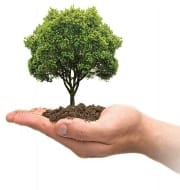India State of Forest Report (ISFR) 2017 released by MoEFCC
The Ministry of Environment, Forest and Climate Change (MoEFCC) has released India State of Forest Report (ISFR) 2017. It has revealed that total forest and tree cover in India has increased of over 8,021 sq km (about 80.20 million hectare) which is one percent increase from 2015.
Key Findings of ISFR 2017
The increase in the forest cover has been observed as 6,778 sq km and that of tree cover as 1, 243 sq km. The total forest and tree cover is 24.39% of geographical area of the country. The increase in forest cover has been observed in Very Dense Forest (VDF) which absorbs maximum carbon dioxide from the atmosphere. It is followed by increase in forest cover in open forest.
India’s Global Position
India is ranked 10th in world, with 24.4% of land area under forest and tree cover, even though it accounts for 2.4 % of the world surface area and sustains needs of 17 % of human and 18 % livestock population. India was placed 8th in list of Top Ten nations reporting the greatest annual net gain in forest area.
State-wise break-up
15 states/UTs have above 33% of geographical area under forest cover. About 40% of country’s forest cover is present in 9 large contiguous patches of the size of 10, 000 sq.km, or more.
7 States/UTs have more than 75% forest cover: Mizoram, Lakshadweep, Andaman & Nicobar Islands, Arunachal Pradesh, Nagaland, Meghalaya and Manipur.
8 States/UTs have forest cover between 33% to 75%: Tripura, Goa, Sikkim, Kerala, Uttarakhand, Dadra & Nagar Haveli, Chhattisgarh and Assam.
Top 5 States with maximum increase in forest cover: Andhra Pradesh (2141 sq km), followed by Karnataka (1101 sq km) and Kerala (1043 sq km), Odisha (885 sq kms) and Telangana (565 sq kms).
Top 5 States with maximum Forest cover (in terms of area): Madhya Pradesh (77,414 sq km) Arunachal Pradesh (66,964 sq km) and Chhattisgarh (55,547 sq km).
Top states with highest Forest cover in terms of percentage geographical area: Lakshadweep with (90.33%), Mizoram (86.27%) and Andaman & Nicobar Islands (81.73%)
Top 5 states where forest cover has decreased: Mizoram (531 sq km), Nagaland (450 sq km), Arunachal Pradesh (190 sq km), Tripura (164 sq km) and Meghalaya (116 sq km). These states are in North Eastern region of the country where total forest cover is very high i.e. more than 70% in each state.
The main reasons for decrease are shifting cultivation, rotational felling, other biotic pressures, diversion of forest lands for developmental activities, submergence of forest cover, agriculture expansion and natural disasters.

Mangrove cover
Mangrove eco-systems are rich in biodiversity and provide number of ecological services. They also play a major role in protecting coastal areas from erosion, tidal storms and tsunamis.
According to ISFR 2017, total mangrove cover stands at 4,921 sq km and has increased by 181 sq kms. 7 out of 12 mangrove states have shown an increase in mangrove cover and none of them show any negative change. Maharashtra (82 sq kms), Andhra Pradesh (37 sq kms) and Gujarat (33 sq kms) are top three gainers in terms of mangrove cover.
Water bodies inside forests
Forests play vital role in water conservation and improve water regime in area. According to ISFR 2017, water bodies inside forest cover have increased by 2,647 sq kms during the last decade. Maharashtra (432 sq kms), Gujarat (428 sq kms), Madhya Pradesh (389 sq kms) are top three states showing increase in water bodies within forest areas. Overall, almost all the states have shown a positive change in water bodies.
Bamboo Cover
The extent of bamboo-bearing area in country is estimated at 15.69 million ha. There has been an increase of 1.73 million ha in bamboo area in comparison to last assessment done in 2011. There is increase of 19 million tonnes in bamboo-growing stock as compared to last assessment done in 2011. The growing stock of bamboo in forest has been estimated to be 189 million tonnes.
Background
The India State of Forest Report 2017 (ISFR 2017) is 15th such report in the series prepared by Forest Survey of India (FSI). The report has been prepared with the help of scientific tools and contains information on forest cover, tree cover, mangrove cover, carbon stock in India’s forests, growing stock inside and outside the forest areas and forest cover in different patch size classes.
The report for first time contains information on decadal change in water bodies in forest during 2005-2015, forest fire, production of timber from outside forest, state wise carbon stock in different forest types and density classes. FSI has been assessing the forest and tree resources of our country on a biennial basis since 1987. The results of the assessment are published in its biennial report titled “India State of Forest Report (ISFR)”.
Month: Current Affairs - February, 2018
2 Comments
Leave a Reply
You must be logged in to post a comment.



Tsapise
August 4, 2018 at 1:08 pmIs it 24.39 % or 21.53 % in terms total geographical area of the country, I’m getting confused because in the your explanation portion it is 24.39 % and in the diagram it is 21.53% ( forest cover area).
Tsapise
August 4, 2018 at 1:08 pmIs it 24.39 % or 21.53 % in terms total geographical area of the country, I’m getting confused because in the your explanation portion it is 24.39 % and in the diagram it is 21.53% ( forest cover area).